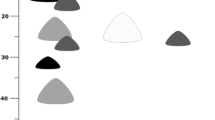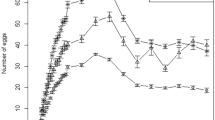Summary
Seventy field-collected colonies of the termiteIncisitermes schwarzi Banks were analyzed in terms of caste- and sex-ratios. The main findings were: (1) approximately equal numbers of males and females were found among the workers in colonies that had not yet begun nymphal and imaginal molts; (2) there was an excess of males among the workers of colonies that had begun to form nymphs and alates, and among the soldiers of all colonies; this is believed to be a secondary effect of the fact that (3) female workers develop into nymphs and alates before males do, and female alates leave the colony, on average, earlier than males; (4) comparison of colonies at a stage before the nymphal molts have begun, with colonies containing nymphs, suggests a loss of about 10 percent of the females during the transition to nymphal stages; (5) one period of alate production occurs per year, lasting about 2 months, with 20 to 50 percent of the workers turning into alates; (6) 26 percent of the colonies had one or both primary reproductives replaced by secondary reproductives, leading to a certain amount of inbreeding; (7) except for greater maturity, there was no apparent difference in composition between colonies headed by primary reproductives and those headed by secondary reproductives; (8) soldiers made up about 7 percent of the average colony, numerically, with small soldiers 3 times as numerous as large soldiers; (9) colonies produce small soldiers first, later adding large soldiers; soldier production is lower when nymphs and alates are forming. The findings are discussed in relation to the reproductive cycle and life cycle of the colony, the amount of inbreeding in the population, and the unusual chromosomal mechanism of sex determination.
Resume
J'ai réalisé une étude de soixante-dix colonies naturelles du termiteIncisitermes schwarzi Banks, en analysant la proportion des sexes et des castes. Les résultats les plus importants sont: (1) les ouvriers mâles et les ouvriers femelles étaient à peu près égaux en nombres dans les colonies qui n'avaient pas encore commencé à faire de nymphes et d'ailés; (2) il y avait un excès de mâles parmi les ouvriers des colonies qui avaient commencé à faire des nymphes et des ailés, et parmi les soldats de toutes les colonies; c'est probablement à cause du fait que (3) les ouvriers femelles se transforment en nymphes et ailés avant les mâles, et les femelles quittent la colonie plus tôt, en moyenne, que les mâles; (4) pendant la transformation d'ouvrier en nymphe, il se peut qu'il y ait une perte d'à peu près 10 pour cent des femelles; (5) il y a une seule période de production d'ailés par an, qui dure environ deux mois; à peu près 20 à 50 pour cent des ouvriers se transforment en ailés; (6) dans 26 pour cent des colonies, un seul ou les deux reproducteurs se trouvent remplacés par des reproducteurs secondaires, produisant une certaine consanguinité; (7) à part une maturité plus avancée, il n'y avait pas de différence apparente de composition entre les colonies des reproducteurs originaux et celles des reproducteurs remplaçants; (8) les soldats constituent environ 7 pour cent de la colonie moyenne, numériquement, les petits soldats étant trois fois plus nombreux que les grands; les colonies produisent d'abord des petits soldats, et les grands plus tard; la production des soldats est plus basse quand les ouvriers se transforment en nymphes et ailés. Les résultats sont discutés par rapport au cycle reproductif et au cycle de vie de la colonie, au degré de consanguinité dans la population, et à l'insolite mécanisme chromosomique déterminant le sexe.
Similar content being viewed by others
References
Alexander R.D., Sherman P.W., 1977. — Local mate competition and parental investment in social insects.Science, 196, 494–500.
Ayala F.J., Powell J.R., Tracey M.L., 1972. — Enzyme variability in theDrosophila willistoni group. V: Genetic variation in natural populations ofDrosophila equinoxialis.Genet. Res., Camb., 20, 19–42.
Baker R.J. 1984. — A sympatric cryptic species of mammal: a new species ofRhogeessa (Chiroptera: Vespertilionidae).Syst. Zool., 33, 178–183.
Bartz S.J., 1979. — Evolution of eusociality in termites.Proc. Natl. Acad. Sci. U.S.A., 76, 5764–5768.
Bess H.A., 1970. — Termites of Hawaii and the Oceanic Islands. In Krishna K., Weesner F.M., eds.Biology of termites, vol. II, 449–476, New York and London, Academic Press.
Castle G.B., 1934. — The damp-wood termites of western United States, genusZootermopsis (formerly,Termopsis); in Kofoid C.A., ed.,Termites and termite control, 2nd ed., 273–310, Berkeley, Univ. of California Press.
Darlington C.D., Gairdner A.E., 1938. — The variation system inCampanula persicifolia.J. Genet., 35, 97–128.
Grassé P.P., Noirot C., 1958. — La société deCalotermes flavicollis (Insecte Isoptère), de sa fondation au premier essaimage.C. R. Acad. Sci. Paris,246, 1789–1795.
Harvey P.A., 1934. — Life history ofKalotermes minor in Kofoid C.A., ed.Termites and termite control, 2nd ed., 217–233, Berkeley, Univ. of California Press.
Haverty M.I., 1977. — The proportion of soldiers in termite colonies: a list and bibliography (Isoptera).Sociobiology, 2, 199–216.
Haverty M.I., 1979. — Soldier production and maintenance of soldier proportions in laboratory experimental groups ofCoptotermes formosanus Shiraki.Ins. Soc., 26, 69–83.
Haverty M.I., Howard R.W., 1981. — Production of soldiers and maintenance of soldier proportions by laboratory experimental groups ofReticulitermes flavipes (Kollar) andReticulitermes virginicus (Banks) (Isoptera: Rhinotermitidae).Ins. Soc., 28, 32–39.
Howard R., Haverty M.I., 1981. — Seasonal variation in caste proportions of field colonies ofReticulitermes flavipes (Kollar).Environ. Entomol., 10, 546–549.
Jones S.C., La Fage J.P., 1980. — A scanning electron microscopic examination of external sexual characteristics of the immature stages and soldiers ofPterotermes occidentis (Walker) andMarginitermes hubbardi (Banks) (Isoptera: Kalotermitidae).Sociobiology, 5, 325–336.
Jones S.C., La Fage J.P., Wright V.L., 1981. — Studies of dispersal, colony caste and sexual composition, and incipient colony development ofPterotermes occidentis (Walker) (Isoptera: Kalotermitidae).Sociobiology, 6, 221–241.
Kalshoven L.G.E., 1930. — De biologie van de djatitermiet (Kalotermes tectonae Damm.) in verband met zijn bestrijding.Mededeelingen van het Instituut voor Plantenziekten, No.76, 1–154.
Larson A., Highton R., 1978. — Geographic protein variation and divergence in the salamanders of thePlethodon welleri group (Amphibia: Plethodontidae).Syst. Zool., 27, 431–448.
Lebrun D., 1985. — The role of hormones in social polymorphism and reproduction inKalotermes flavicollis Fabr.; in Watson J.A.L., Okot-Kotber B.M., Noirot Ch., eds.,Caste Differentiation in Social Insects (Odhiambo T.R., ed.,Current Themes in Tropical Science, vol. 3), 227–238, Oxford, Pergamon Press.
Lüscher M., 1961. — Social control of polymorphism in termites.Roy. Entom. Soc. Lond., Symp. no. 1, 57–67.
Luykx P., 1981. — A sex-linked esterase locus and translocation heterozygosity in a termite.Heredity, 46, 315–320.
Luykx P., 1985. — Genetic relations among castes in lower termites; in Watson J.A.L., Okot-Kotber, B.M., Noirot Ch., eds.,Caste Differentiation in Social Insects (Odhiambo T.R., ed.,Current Themes in Tropical Science, vol. 3), 17–25, Oxford, Pergamon Press.
Luykx P., Syren R.M., 1979. — The cytogenetics ofIncisitermes schwarzi and other Florida termites.Sociobiology, 4, 191–209.
Miller E.M., 1949. —A handbook on Florida termites, Tech. Ser., Coral Gables, Univ. of Miami Press.
Miller E.M., 1969. — Caste differentiation in the lower termites. In Krishna K., Weesner F.M., eds.,Biology of termites, vol. I, 283–310, New York and London, Academic Press.
Nagin R., 1972. — Caste determination inNeotermes jouteli (Banks).Ins. Soc., 19, 39–61.
Nijhout H.F., Wheeler D.E., 1982. — Juvenile hormone and the physiological basis of insect polymorphisms.Quart. Rev. Biol., 57, 109–133.
Nutting W.L., 1965. — The seasonal flights ofPterotermes andZootermopsis in southern Arizona.Proc. 2nd Workshop on Termite Research, Building Research and Advisory Board, Natl. Acad. Sci., Natl. Res. Council, 8–10.
Nutting W.L., 1966. — Distribution and biology of the primitive dry-wood termitePterotermes occidentis (Walker) (Kalotermitidae).Psyche, 73, 165–179.
Nutting W.L., 1969. — Flight and colony foundation. In Krishna K., Weesner F.M., eds.,Biology of Termites, vol. I, 233–282, New York and London, Academic Press.
Nutting W.L., 1970. — Composition and size of some termite colonies in Arizona and Mexico.Ann. Entomol. Soc. Amer., 63, 1105–1110.
Nutting W.L., 1979. — Termite flight periods: strategies for predator avoidance.Sociobiology, 4, 141–151.
Roonwal M.L., 1975. — Sex ratios and sexual dimorphism in termites.J. Scient. and Indust. Res. (India),34, 402–416.
Sands W.A., 1965. — Alate development and colony foundation in five species ofTrinervitermes (Isoptera: Nasutitermitinae) in Nigeria, West Africa,Ins. Soc., 12, 117–130.
Santos O., Luykx P., 1985. — Holozygosity for sex-linked genes in males of the termiteIncisitermes schwarzi.Biochemical Genetics, 23, 729–740.
Spiess E.B., 1977. —Genes in populations, ch. 9, New York, Wiley.
Syren R.M., Luykx P., 1977. — Permanent segmental interchange complex in the termiteIncisitermes schwarzi.Nature, 266, 167–168.
Thorne B.L., 1983. — Alate production and sex ratio in colonies of the neotropical termiteNasutitermes corniger (Isoptera: Termitidae).Oecologia 58, 103–109.
Tyson J.J., 1984. — Evolution and eusociality in diploid species.Theor. Pop. Biol., 26, 283–295.
Uyenoyama M., 1984. — Inbreeding and the evolution of altruism under kin selection: effects on relatedness and group structure.Evolution, 38, 778–795.
Wade M.J., Breden F., 1981. — Effect of inbreeding on the evolution of altruistic behavior by kin selection.Evolution, 35, 844–858.
Wilson E.O., 1985. — The sociogenesis of insect coloniesScience, 228, 1489–1495.
Author information
Authors and Affiliations
Rights and permissions
About this article
Cite this article
Luykx, P. Termite colony dynamics as revealed by the sex- and caste-ratios of whole colonies ofIncisitermes schwarzi banks (Isoptera: Kalotermitidae). Ins. Soc 33, 221–248 (1986). https://doi.org/10.1007/BF02224243
Received:
Accepted:
Issue Date:
DOI: https://doi.org/10.1007/BF02224243




